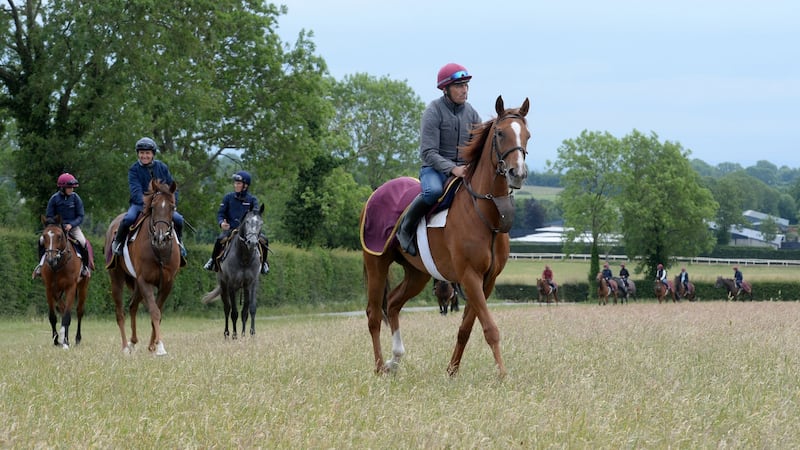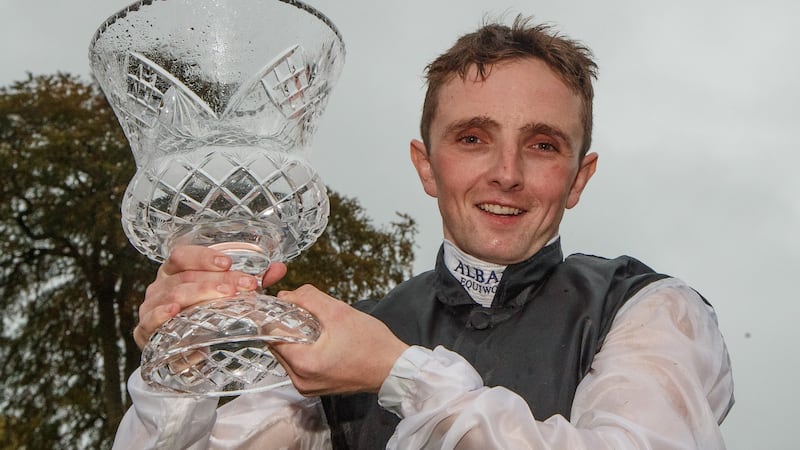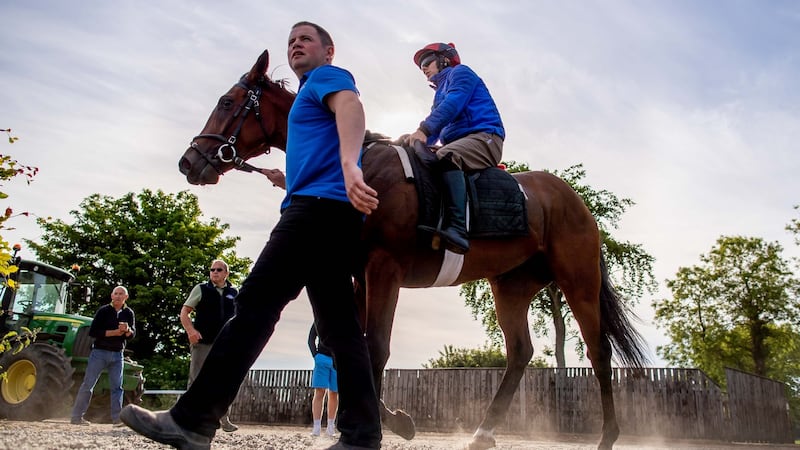Michael Halford’s response when asked what the last 11 weeks have been like is simple: “The same, but different.”
It sounds a contradictory statement from one of the country’s top trainers but also a logical representation of Irish racing’s reality through the coronavirus pandemic.
Shutting up and walking away isn’t an option when thousands of thoroughbreds require attention every day.
So the daily back-shop routine of training and maintaining a racehorse has continued throughout the Covid-19 emergency. To everyone’s huge relief the shop window is back on Monday. Ireland’s first major competitive sporting action since the March 24th lockdown will take place at Naas.
There too it will be the same but different. Horses and jockeys competing to get to the finish line first is substantially the same as ever. Much of what surrounds it will look alien.
A strict behind closed doors policy with numbers of people restricted to the absolute minimum needed to run the fixture is a pale and sterile facsimile of a normal race meeting.
There will be no one to urge and curse from the stands, no bookmakers standing on boxes to bet with, not even a place to buy an overpriced and under-heated burger. The overarching dread provoked by the virus threat means any atmosphere will be more fraught than fun.
But the fact it goes ahead at all represents a victory for racing and for sport generally.
In the face of an existential foe it fits that the game once famously labelled a ‘magnificent triviality’ should throw a first sporting counterpunch towards some kind of normality.

That it is able to underlines how racing, and it’s reported €2 billion value to the Irish economy, is always both different and the same.
"We're a sport attached to an industry and that industry is massive," Halford said earlier this week at his base near Kildare town. "But it's racing that keeps all the wheels turning. The sales and everything else feeds off racing. So it's vital we get this right."
Racing's outdoor and non-contact nature means it gets a head-start on other sports. It's why it has continued without interruption behind closed doors in Hong Kong and Australia. It resumed in Britain last Monday despite the proportionally greater impact of Covid-19 there.
That the Irish authorities gave a green light to resume a week later than Britain – and only after extensive efforts by Horse Racing Ireland to move the start date forward – indicates how cautious health officials continue to be.
Evidence of that is all over the 77 pages of protocols issued by HRI in conjunction with the Irish Horseracing Regulatory Board that convinced the Government to give a green light.
The requirement for jockeys to wear face masks will be the most visible evidence of a document that will never be mistaken for easy reading but which is a template for other sports to copy in arguing their own case to start back.
Anyone required to go racing has to fill out a health questionnaire at least 24 hours beforehand. Everyone going into the track will have their temperature checked. No one over 70 can go. Neither can owners. Social distancing will be strictly enforced and surface cleaning continuous.
Naas has been chosen to host the first of a revamped fixture list because it hosted a behind closed meeting for the start of the Flat season on March 23rd. It was one of 10 such fixtures held before lockdown that were widely judged a logistical success.
“Even then we weren’t as aware of social distancing. Everyone is aware of it now,” said Eamonn McEvoy, the manager of Naas racecourse. “A lot of this is about personal responsibility. Everyone in the industry needs it to go well, so everyone has to play along.
"I'm sure everyone will adhere to social distancing and the common sense things we have been doing all along"
“I think there will definitely be better social distance practising seen here than has been seen in a lot of parks that we see on social media.”
The track will be the focus of national attention on Monday as some sort of summer sporting season begins.
One of the most visible social distancing measures will be painted ‘standing point’ squares in the parade ring. The attention to detail is such that if a rider needs even the faintest split-second lift to get into the saddle the person doing the lifting will have to sanitise their hands immediately.
A one-way system will operate for jockeys to weigh-out and weigh-in. They are being encouraged to stay in their cars in between races. Valets will hand equipment to them as necessary. Regulatory officials will be behind screens. Once riders are finished for the day they must leave immediately.
“They are not allowed to put their backside down in the weighroom,” McEvoy said. Other measures will be less visible, including the thermal screening system that everyone arriving at the track will have to go through. Failure to meet any of the entry criteria will see people turned away.
Some may find the measures laborious but Halford has been carrying out his versions throughout the last 11 weeks.
He has been regularly checking the temperatures of his near 30-strong staff. Along with steps such as limiting access to the tack room to one at a time, closure of the stable canteen, to everyone taking tea breaks in their car, working around the restrictions has become standard drill.
“Horses are creatures of habit. So what’s strong in yards is routine. Everyone likes to know what’s expected of them. So once I said to the lads ‘this is the way it is’ they were really very good,” he said.
As a HRI board member Halford is well aware of the flak racing has endured in recent months. In particular the sport here got caught in the reputational blowback of the British decision to let the Cheltenham Festival go ahead.
Some critics will portray Monday’s action in terms of an elitist plaything, or fodder for gambling corporations, maybe even a jarring slice of frivolity during a torrid time. Many more however are likely to see evidence of the first live sport in 11 weeks and an industry behind it starting up again.
“My mother is in her late 70s, she’s been through cancer treatment and has lost her hearing. I’ve a mentally handicapped brother living with her. I haven’t been inside my mother’s door since the middle of February. The minute it started she was in isolation. I take the kids over, she stands at the front door, we’re at the wall of the garden, and she’s hard of hearing!” Halford smiled.
“When you’re talking about people’s lives, it’s not something anyone takes for granted. There is a bigger picture.
“I see it as everyone’s duty to do what’s right. In racing we’ve been living with this for the last 13 weeks. It has become the norm. Subconsciously you just do what has to be done.
“I’m sure everyone will adhere to social distancing and the common sense things we have been doing all along,” he added. “It’s not a big price to pay to get back racing.”
READY FOR THE OFF
Chris Hayes (Jockey)

“I’m a little bit heavier than I would normally be this time of year but when you’re not competing for 10 or 11 weeks that’s only to be expected. I’m 8st 6 or 7 every morning so lots of lads would kill to be in my position.
“Lockdown has been frustrating but it was good to get the date and I think I can speak for everyone in saying we’re all raring to go now.
“I haven’t ridden in work in a face mask but I have been running and cycling in it. I saw Frankie [Dettori] was training with it so I thought it wouldn’t be a bad idea. You wouldn’t put blinkers on a horse without trying them at home first.
“I found it a bit restrictive when I first started wearing the mask but I’ve got used to it. You don’t have to wear it during a race. But in case there’s a change of rules at least now I wouldn’t be going in struggling to catch my breath.
“Hopefully we won’t have to do it for too long. But if it is long-term it’s something we’ll have to grin and bear. I’d do anything to get back racing.”
Jim Martin (CEO Dundalk Racecourse)
“There’s no doubt racing behind closed doors is commercially difficult for racecourses. But it’s good to be back racing and we’ll make the best of it.
“Hopefully behind closed doors is a stage. We all want to get to a point where people can go racing again. It’s hard to say when but from my understanding some amount of the public may be allowed after August 10th.
“But I don’t think you’re going to go from behind closed doors to thousands of people at the races. It will be staged.
“There are interesting times ahead. The news that bookmaker shops in the UK are reopening soon is good. From a media rights point of view that’s positive news for racecourses as well.”
Andrew Duff (Asst Trainer to Ger Lyons)
“It will be different but I can’t see the protocols being much of an inconvenience. Everyone’s had enough videos and memos so they should know where they’re going. We set up a WhatsApp group in the yard and everyone who goes racing is added. People are really buying into it.

“We normally start in March so no one’s gone anywhere. There’s an air of anticipation. This is getting racing going again so everyone’s willing to do whatever needs to be done.
“We have a horsebox that takes seven runners and up to eight staff. But obviously now it will be driver and a front seat passenger. We’ve a living area in the back which caters for six but we’re putting two people in that, on opposite sides of the lorry. Others will travel in their cars.
“It’s just simple things really. We’ll leave a bit earlier. One or two lads will leave separately and get tested first. That means others can leave the box and someone will always be with the horses and can be there to get stables ready. I’m sure everything will run as smoothly as possible.”
Edward Lynam (Trainer)
“The way we work, we’re all outdoors and social distancing anyway. They all social distance from me because I’m a grumpy sod!
"But we're lucky. I've a daughter living in an apartment near Leopardstown, with a normal job and a normal life, and she's much more cooped up. You know a lot of people were in a worse place.
“Our mornings have been the exact same. You went in, looked after the horses, rode them out. It was a normal day – but with no racing.
“Hopefully we can get some sort or normality back. Racing without spectators – and they’re thin on the ground anyway – and without the betting ring, the longer it goes on, the harder it will be to get them back.
“I’ve been to some of the behind closed doors meetings. Trust me, it’s a bleak experience.”













